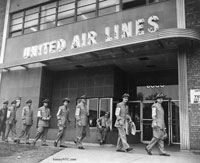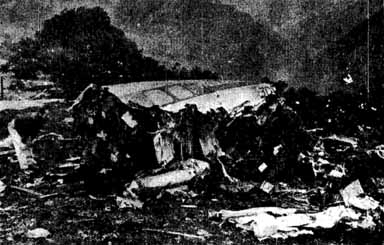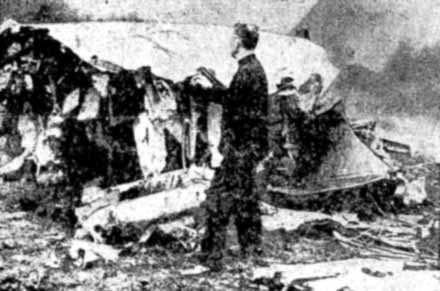The Boys of Summer...
The Douglas DC-6 was originally designed during World War II for the United States military as an improved version of the C-54 Skymaster. With a pressurized cabin, and stronger engines, it was a far superior aircraft to the Skymaster, but by the time of the flight of first prototype in 1946, the war was over, and the primary need of the aircraft disappeared.
However, the post-war years in the United States saw a boom in personal travel, and the airlines were in heavy competition to move as many people as fast as possible. The Douglas Aircraft Company filled the airline's need to a tee, and provided an alternative to the Lockheed Constellation in the realm of long-range transport aircraft.
And in 1951, Douglas introduced the DC-6B, a larger and faster model. Powered by four Pratt & Whitney R-2800-CB-17 engines, producing 2,500 horsepower each, and equipped with Hamilton Standard 43E60 constant speed reversing propellers, it was regarded as one of the best combinations of power, reliability, and handling ever in a production aircraft. It could fly its passengers further, faster, cheaper.
And that was a problem for its pilots.

|
Pilots of United Air Lines form a picket line as they march past the airline's entrance at Chicago's Midway airport |
The Airline Pilots Association, founded in 1931 and part of the American Federation of Labor, had instigated a strike, in June of 1951, against United Airlines over the pay of pilots of the DC-6B. The union argued that, since the new model could fly faster and farther than its predecessors, they were entitled to a change in their wage base to compensate for carrying bigger payloads in shorter time. The pilots' strike ended in a government-engineered truce in early July, and United announced on August 1st that the pilots had agreed to fly the new DC-6Bs.
A Transcontinental Red-Eye...
United Flight 615 departed Boston at 5:32 P.M., Eastern Time, made its scheduled stops in Hartford, Connecticut, and in Cleveland, Ohio, arriving in Chicago, Illinois, at 7:59 P.M., Central Time. The flight departed Chicago an hour later, bound for Oakland, the last and longest leg of the flight.
At 3:54 A.M., Pacific Time, and while approaching the San Francisco Bay area, Flight 615 was cleared to the Newark, California fan marker, with instructions to descend to 6,000 feet, maintain that altitude, and contact Oakland Approach Control over Altamont.
At 04:11, the flight reported their position over Stockton, California, at 9,500 feet and descending. The weather was reported as having a cloud base at 1500 feet with patches of fog obscuring terrain.
Five minutes later, they were over the Altamont Intersection, east of Livermore. The flight was then cleared, by Approach Control, to the Oakland radio range station, and instructed to maintain at least 500 feet above the tops of the clouds. The pilot followed this contact with a request for clearance direct to Newark and a straight-in range approach. This request was granted, with instructions to maintain the 500 feet clearance over the cloud layer between the Altamont intersection and Newark marker.
At 4:25, Flight 615 was cleared for a straight-in approach to Oakland Airport on the southeast course of the Oakland radio range from Newark. At 4:27 the flight reported leaving Newark inbound to Oakland. This was the last radio contact.
The aircraft descended until it struck rising mountainous terrain at 983 feet above sea level, and 26 feet below the crest of the hill, now named Tolman Peak, at a point about three miles to the right of the southeast on-course signal of the Oakland radio range, 15 miles southeast of Oakland Airport.
The major portion of the structure hurtled over the top of the knoll, scattering on the downslope and into the ravine, Dry Gulch Canyon, below.
Click here to read the Crew & Passenger List of UAL Flight 615
 | 
|
A frontal portion of the fuselage, split open from impact | A Catholic priest giving 'Last Rites' to the crash victims over the still-smoldering wreckage of the plane |
| | |
| | |
| | |
| |
According to the Post Office, most of the 3900 pounds of mail aboard the plane was recovered. Many of the mail sacks had split, spilling letters and packages for many yards, scorching and tearing many of the envelopes. Of the load, nearly 15,000 pieces of mail aboard was destined for the Canal Zone in Panama. Damaged mail recovered from this accident was marked with a distinctive cachet, stating "Attached piece of mail was damaged by plane accident August 24, 1951, at Decoto, Calif"
After an investigation, it was determined that the pilot ignored the prescribed instrument landing procedures. The pilot instead relied on visual reference, using the copilot's automatic direction finder (ADF). The ADF threw the plane three miles off course and below the prescribed altitude of 3,500 feet.
United uses the "Flight 615" designation today on a Washington (Dulles)-Chicago (O'Hare) route.
